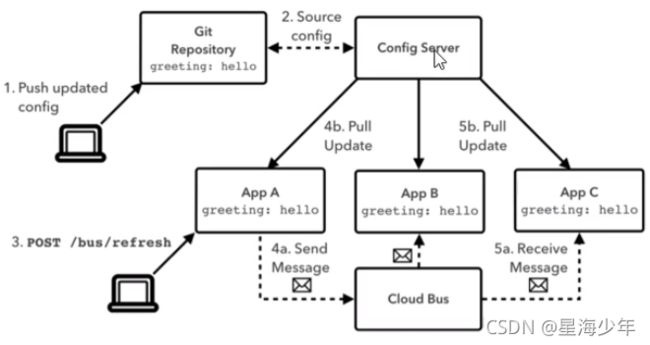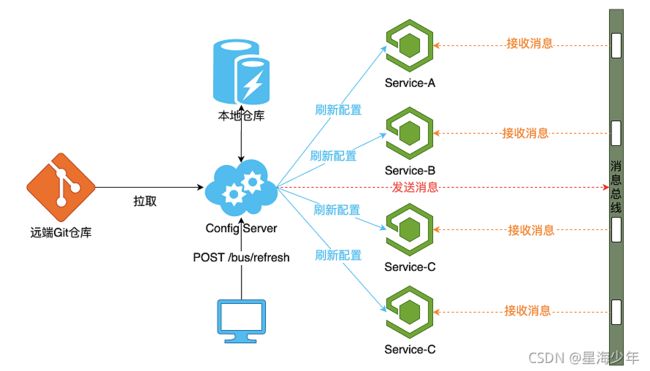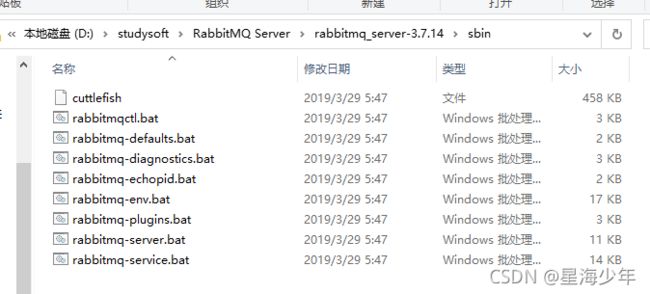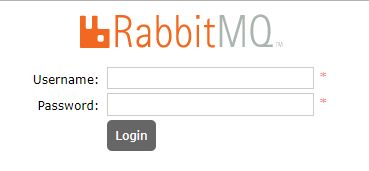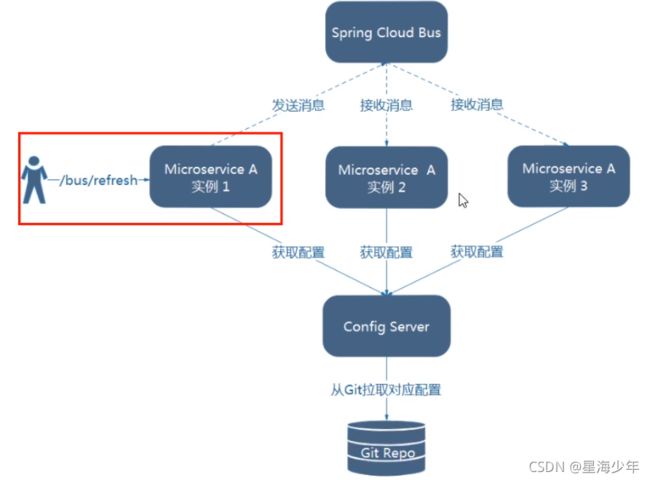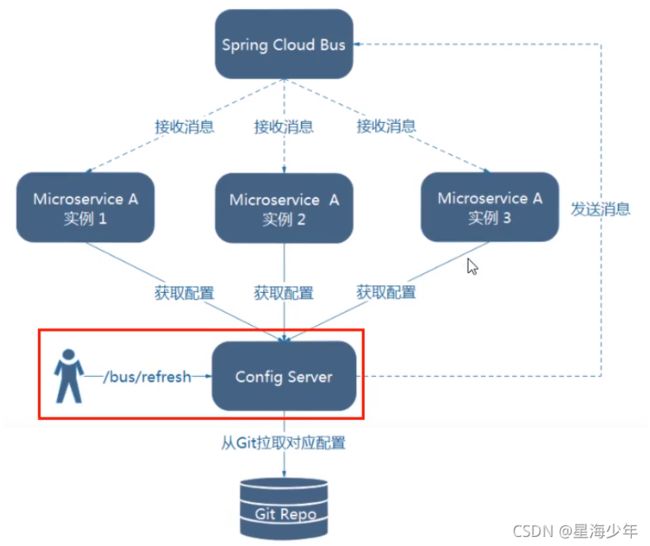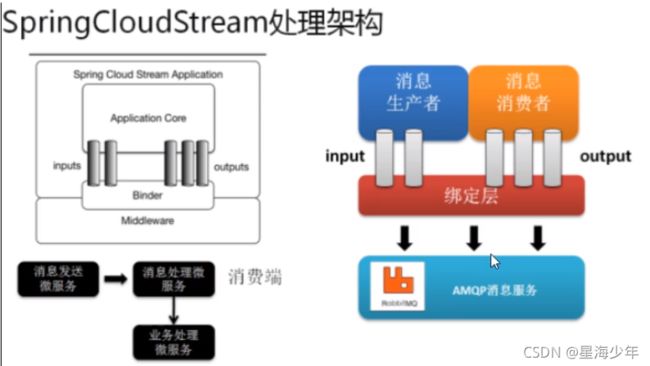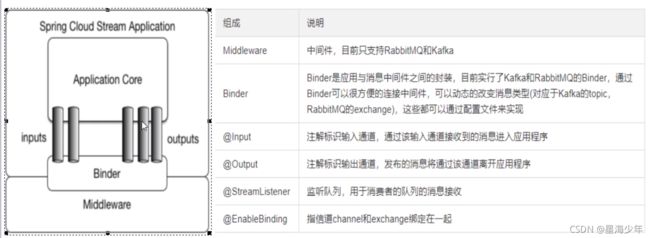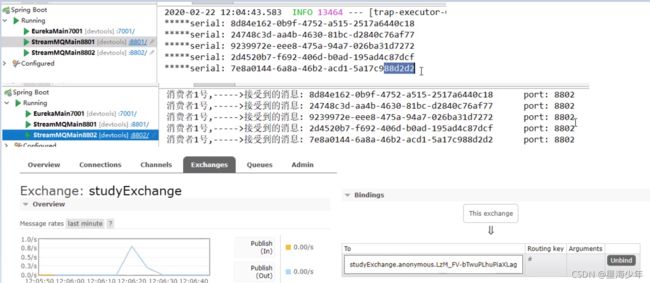SpringCloud(十一)Bus消息总线、Stream消息驱动
一、Bus消息总线
需求:分布式自动刷新配置功能;
解决:SpringCloud Bus配合Spring cloud Config使用可以实现配置的动态刷新。
1、概述
定义:Spring Cloud Bus是用来将分布式系统的节点与轻量级消息系统链接起来的框架,它整合了Java的事件处理机制和消息中间件的功能。
Spring Clud Bus目前支持RabbitMQ和Kafka。
通俗定义:bus称之为springcloud中消息总线,主要用来在微服务系统中实现远端配置更新时通过广播形式通过所有客户端刷新配置信息,避免手动重启服务的工作。
能干什么?
Spring Cloud Bus能管理和传播分布式系统间的消息,就像一个分布式执行器, 可用于广播状态更改、事件推送等,也可以当作微服务间的通信通道。
为何被称为总线?
在微服务架构的系统中,通常会使用轻量级的消息代理来构建一个共用的消息主题, 并让该系统中所有微服务实例都连接上来。由于该主题中产生的消息会被所有实例监听和消费,所以称它为消息总线。在总线上的各个实例,都可以方便地广播一些需要让其他连接在该 主题上的实例都知道的消息。
基本原理
ConfigClient实例都监听MQ中同一个topic(默认是springCloudBus)。当一个服务刷新数据的时候,它会把这个信息放入到Topic中,这样其它监听同一Topic的服务就能得到通知,然后去更新自身的配置。
2、RabbitMQ环境配置
- 安装Erlang,下载地址:opt_win64_21.3.exe
- 安装RabbitMQ,下载地址:rabbitmq-server 3.7.14
- 进入RabbitMQ安装目录下的sbin目录
- 输入以下命令启动管理功能
- 在sbin目录下运行命令行窗口cmd
- 输入命令
rabbitmq-plugins enable rabbitmq management,这样就可以添加可视化插件了。 - 这样就添加了rabbitmq界面,只需要启动rabbitmq即可
- 访问地址查询是否安装成功:
在浏览器上输入 http://127.0.0.1:15672
- 输入账号密码并登录:guest guest
3、SpringCloud Bus动态刷新全局广播
必须先具备良好的RabbitMQ环境
为了实现广播效果,我们新建3366微服务(同3355模块)
- cloud-config-client-3366
- POM
- YML
- 启动类
- controller
设计思想:
1)利用消息总线触发一个客 户端/bus/refresh,而刷新所有客户端的配置
2)利用消息总线触发一个服务端ConfigServer的/bus/refresh端点,而刷新所有客户端的配置
图二的架构显然更加适合,图一不适合的原因如下:
- 打破了微服务的职责单一-性,因为微服务本身是业务模块,它本不应该承担配置刷新的职责。
- 破坏了微服务各节点的对等性。
- 有一定的局限性。例如,微服务在迁移时,它的网络地址常常会发生变化,此时如果想要做到自动刷新,那就会增加更多的修改
具体实现步骤:
- 给cloud-config-center-3344配置中心服务端添加消息总线支持
- POM
<dependency>
<groupId>org.springframework.cloudgroupId>
<artifactId>spring-cloud-starter-bus-amqpartifactId>
dependency>
<dependency>
<groupId>org.springframework.bootgroupId>
<artifactId>spring-boot-starter-actuatorartifactId>
dependency>
- YML:注意写的位置要对齐
#rabbit相关配置
rabbitmq:
host: localhost
port: 5672
username: guest
password: guest
#rabbitmq相关配置,暴露bus刷新配置的端点
management:
endpoints: #暴露bus刷新配置的端点
web:
exposure:
include: 'bus-refresh' #凡是暴露监控、刷新的都要有actuator依赖,bus-refresh就是actuator的刷新操作
- 给cloud-config-client-3355客户端添加消息总线支持
- POM
<dependency>
<groupId>org.springframework.cloudgroupId>
<artifactId>spring-cloud-starter-bus-amqpartifactId>
dependency>
<dependency>
<groupId>org.springframework.bootgroupId>
<artifactId>spring-boot-starter-actuatorartifactId>
dependency>
- YML
#rabbit相关配置 15672是web管理界面的端口,5672是MQ访问的端口
rabbitmq:
host: localhost
port: 5672
username: guest
password: guest
- 给cloud-config-client-3366客户端添加消息总线支持
- 操作同上
- 测试如下
- 修改GitHub上配置文件新增版本号
- 只需要3344发一次,其他处处生效:
curl -X POST "http://localhost:3344/actuator/bus-refresh" - 查询配置中心:http://config-3344:3344/config-dev.yml
- 查看客户端:http://localhost:3355/configInfo;http://localhost:3366/configInfo
此时获取配置信息,发现后已经刷新了
一次修改,广播通知,处处生效
4、SpringCloud Bus动态刷新定点通知
需求:不想全部通知,只想定点通知。只通知3355,不通知3366
简单来说:
- 指定具体某一个实例生效而不是全部
- 公式:
http://localhost:配置中心的端口号/actuator/bus-refresh/{destination} - /bus/refresh请求不再发送到具体的服务实例上,而是发给config server并通过destination参数类指定需要更新配置的服务或实例
具体实现:
curl -X POST "http://localhost:3344/actuator/bus-refresh/config-client:3355"
总结:
二、Stream消息驱动
1、消息驱动概述
定义:屏蔽底层消息中间件的差异,降低切换成本,统一消息的编程模型。
1. 什么是SpringCloud Stream?
官方定义Spring Cloud Stream是一个构建消息驱动微服务的框架。
应用程序通过inputs或者outputs与Spring Cloud Stream中binder对象交互。
通过我们配置来binding(绑定),而Spring Cloud Stream的binder对象负责与消息中间件交互。
所以,我们只需要搞清楚如何与Spring Cloud Stream交互就可以方便使用消息驱动的方式。
通过使用Spring Integration来连接消息代理中间件以实现消息事件驱动。
Spring Cloud Stream为一些供应商的消息中间件产品提供了个性化的自动化配置实现,引用了发布-订阅、消费组、分区的三个核心概念。
目前仅支持RabbitMQ、Kafka
官网文档
SpringCloud Steam中文指导手册
2. 设计思想
标准MQ(没有引出Springcloud):
- 生产者/消费者之间靠消息媒介传递信息内容:Message
- 消息必须走特定的通道:消息通道MessageChannel
- 消息通道里的消息如何被消费呢,谁负责收发处理:消息通道MessageChannel的子接口SubscribleChannel,由MessageHandle消息处理器锁订阅
为什么要用Cloud Stream?
这些中间件的差异性导致我们实际项目开发给我们造成了一定的困扰,我们如果用了两个消息队列的其中一种,后面的业务需求,我想往另外一种消息队列进行迁移,这时候无疑就是一个灾难性的,一大堆东西都要重新推倒重新做,因为它跟我们的系统耦合了,这时候springcloud Stream给我们提供了一种解耦合的方式。
Stream凭什么可以统一底层差异?
在没有绑定器这个概念的情况下,我们的SpringBoot应用要直接与消息中间件进行信息交互的时候,于各消息中间件构建的初衷不同,它们的实现细节上会有较大的差异性
通过定义绑定器作为中间层,完美地实现了应用程序与消息中间件细节之间的隔离。
通过向应用程序暴露统一的Channel通道, 使得应用程序不需要再考虑各种不同的消息中间件实现。
通过定义绑定器Binder作为中间层,实现了应用程序与消息中间件细节之间的隔离。
Binder
通过定义绑定器Binder作为中间层,实现了应用程序与消息中间件细节之间的隔离。
Stream中的消息通信方式遵循了发布-订阅模式:Topic主题进行广播
- 在RabbitMQ就是Exchange
- 在Kakfa中就是Topic
3. Springcloud Stream标准流程套路
- Binder:很方便的连接中间件,屏蔽差异
- Channel:通道,是队列Mueue的一种抽象,在消息通讯系统中就是实现存储和转发的媒介,通过Channel对队列进行配置
- Source和Sink:简单的可理解为参照对象是Spring Cloud Stream自身,从Stream发布消息就是输出,接受消息就是输入。
4. 编码API和常用注解
2、案例说明
RabbitMQ环境是通的;
工程中创建三个子模块;
1)cloud-stream-rabbitmq-provider8801:作为生产者进行发消息模块
2)cloud-stream-rabbitmq-consumer8802:作为消息接收模块
3)cloud-stream-rabbitmq-consumer8803:作为消息接收模块
3、消息驱动之生产者
-
新建cloud-stream-rabbitmq-provider8801
-
POM
<dependencies>
<dependency>
<groupId>org.springframework.bootgroupId>
<artifactId>spring-boot-starter-webartifactId>
dependency>
<dependency>
<groupId>org.springframework.bootgroupId>
<artifactId>spring-boot-starter-actuatorartifactId>
dependency>
<dependency>
<groupId>org.springframework.cloudgroupId>
<artifactId>spring-cloud-starter-netflix-eureka-clientartifactId>
dependency>
<dependency>
<groupId>org.springframework.cloudgroupId>
<artifactId>spring-cloud-starter-stream-rabbitartifactId>
dependency>
<dependency>
<groupId>org.projectlombokgroupId>
<artifactId>lombokartifactId>
<optional>trueoptional>
dependency>
<dependency>
<groupId>org.springframework.bootgroupId>
<artifactId>spring-boot-starter-testartifactId>
<scope>testscope>
dependency>
dependencies>
- YML
server:
port: 8801
spring:
application:
name: cloud-stream-provider
cloud:
stream:
binders: # 在此处配置要绑定的rabbitMQ的服务信息
defaultRabbit: # 表示定义的名称,用于binding的整合
type: rabbit # 消息中间件类型
environment: # 设置rabbitMQ的相关环境配置
spring:
rabbitmq:
host: localhost
port: 5672
username: guest
password: guest
bindings: # 服务的整合处理
ouput: # 这个名字是一个通道的名称
destination: studyExchange # 表示要使用的exchange名称定义
content-type: application/json # 设置消息类型,本次为json,文本则设为text/plain
#binder: defaultRabbit # 设置要绑定的消息服务的具体设置
eureka:
client:
service-url:
defaultZone: http://eureka7001.com:7001/eureka
instance:
lease-renewal-interval-in-seconds: 2 # 设置心跳的间隔时间,默认30
lease-expiration-duration-in-seconds: 5 # 超过5秒间隔,默认90
instance-id: send-8801.com # 主机名
prefer-ip-address: true # 显示ip
- 主启动类
@SpringBootApplication
public class StreamMQMain8801 {
public static void main(String[] args) {
SpringApplication.run(StreamMQMain8801.class, args);
}
}
- 业务类
发送接口实现类
//这不是传统的service,这是和rabbitmq打交道的,不需要加注解@Service
//这里不调用dao,调用消息中间件的service
//信道channel和exchange绑定在一起
@EnableBinding(Source.class) // 定义消息推动管道
public class MessageProviderImpl implements MessageProvider {
// 消息发送管道
@Resource
private MessageChannel output;
@Override
public String send() {
String serial = UUID.randomUUID().toString();
output.send(MessageBuilder.withPayload(serial).build());
System.out.println("serial = " + serial);
return null;
}
}
Controller
@RestController
public class SendMessageController {
@Resource
private MessageProvider messageProvider;
@GetMapping("/sendMessage")
public String sendMessage(){
return messageProvider.send();
}
}
- 测试
1)启动7001
2)rabbitMQ:http://localhost:15672
3)启动8801
4)访问:http://localhost:8801/sendMessage
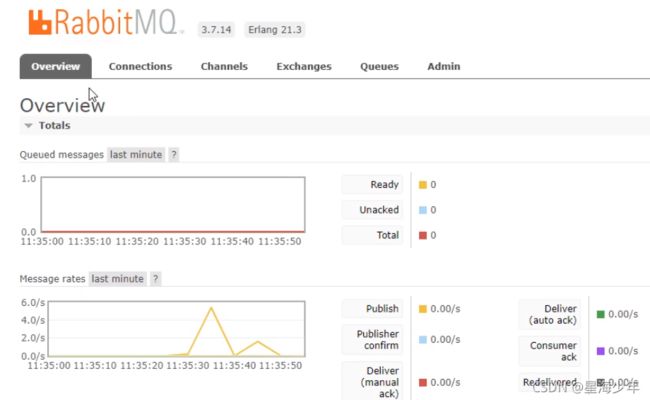
4、消息驱动之消费者
- 新建cloud-stream-rabbitmq-consumer8802
- POM
<dependencies>
<dependency>
<groupId>org.springframework.bootgroupId>
<artifactId>spring-boot-starter-webartifactId>
dependency>
<dependency>
<groupId>org.springframework.bootgroupId>
<artifactId>spring-boot-starter-actuatorartifactId>
dependency>
<dependency>
<groupId>org.springframework.cloudgroupId>
<artifactId>spring-cloud-starter-netflix-eureka-clientartifactId>
dependency>
<dependency>
<groupId>org.springframework.cloudgroupId>
<artifactId>spring-cloud-starter-stream-rabbitartifactId>
dependency>
<dependency>
<groupId>org.projectlombokgroupId>
<artifactId>lombokartifactId>
<optional>trueoptional>
dependency>
<dependency>
<groupId>org.springframework.bootgroupId>
<artifactId>spring-boot-starter-testartifactId>
<scope>testscope>
dependency>
dependencies>
- YML
server:
port: 8802
spring:
application:
name: cloud-stream-consumer
cloud:
stream:
binders: # 在此处配置要绑定的rabbitMQ的服务信息
defaultRabbit: # 表示定义的名称,用于binding的整合
type: rabbit # 消息中间件类型
environment: # 设置rabbitMQ的相关环境配置
spring:
rabbitmq:
host: localhost
port: 5672
username: guest
password: guest
bindings: # 服务的整合处理
input: # 这个名字是一个通道的名称
destination: studyExchange # 表示要使用的exchange名称定义
content-type: application/json # 设置消息类型,本次为json,文本则设为text/plain
#binder: defaultRabbit # 设置要绑定的消息服务的具体设置
#group: atguiguA
eureka:
client:
service-url:
defaultZone: http://eureka7001.com:7001/eureka
instance:
lease-renewal-interval-in-seconds: 2 # 设置心跳的间隔时间,默认30
lease-expiration-duration-in-seconds: 5 # 超过5秒间隔,默认90
instance-id: receive-8802.com #主机名
prefer-ip-address: true # 显示ip
- 主启动类
@SpringBootApplication
public class StreamMQMain8802 {
public static void main(String[] args) {
SpringApplication.run(StreamMQMain8802.class, args);
}
}
- 业务类
@Component
@EnableBinding(Sink.class)
public class ReceiveMessageListenerController {
@Value("${server.port}")
private String serverPort;
@StreamListener(Sink.INPUT)
public void input(Message<String> message){
System.out.println("消费者1号,------->接收到的消息: "+message.getPayload()+"\t port: "+serverPort);
}
}
- 测试8801发送8802接收消息
访问:http://localhost:8801/sendMessage
5、分组消费与持久化
- 依照8802,clon出来一个运行8803:cloud-stream-rabbitmq-consumer8803
- 启动
RabbitMQ,7001(服务注册),8801(消息生产),8802(消息消费),8803(消息消费)
- 运行后有两个问题
- 重复消费问题
- 消息持久化问题
- 消费
目前8802/8803 同时都接收到了,存在重复消费问题
如何解决:分组和持久化
生产中实际案例:
比如在如下场景中,订单系统我们做集群部署,都会从RabbitMQ中获取订单信息,那如果一个订单同时被两个服务获取到,那么就会造成数据错误,我们得避免这种情况。
这时我们就可以使用Stream中的消息分组来解决。
注意:在Stream中处于同一个group中的多个消费者是竞争关系,就能够保证消息只会被其中一个应用消费一次。
不同组是可以全面消费的(重复消费),同一组内会发生竞争关系,只有其中一个可以消费。
- 分组
原理:
微服务应用放置于同一个group中,就能够保证消息只会被其中一个应用消费一次。
不同的组是可以消费的,同一个组内会发生竞争关系,只有其中一个可以消费。
1)8802/8803都变成不同组,group两个不同
修改8002YML
group: atguiguA
修改8003YML
group: atguiguB
所以:8802/8803实现了轮询分组,每次只有一个消费者;8801模块的发的消息只能被8802或8803其中一个接收到,这样避免了重复消费。
2)8802/8803都变成相同组,group两个相同
修改8002YML
group: atguiguA
修改8003YML
group: atguiguA
结论:同一个组的多个微服务案例,每次只会有一个能拿到。
- 持久化
- 通过上述,解决了重复消费问题,再看看持久化
- 停止8802/8803并去除掉8802的分组group: atguiguA,8803的分组group:atguiguA没有去掉。
- 8801先发送4条消息到rabbitmq
- 先启动8802,无分组属性配置,后台没有打出来消息。
- 再启动8803,有分组属性配置,后台打出来了MQ上的消息。
如果有收获!!! 希望老铁们来个三连,点赞、收藏、转发。
创作不易,别忘点个赞,可以让更多的人看到这篇文章,顺便鼓励我写出更好的博客
